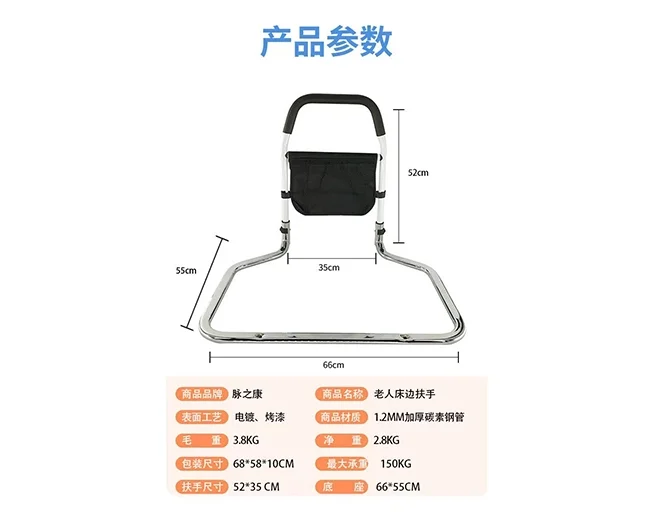Evaluating Bedside Handrails: Clinical Benefits for Older Adults’ Safety
Time : Aug 29, 2025 View : 1,395
As the world’s population gets older, keeping seniors safe yet free in healthcare settings is a big deal. Bedside handrails are a key tool in looking after older folks. They help prevent falls while letting people move on their own terms. These tools give solid support, build confidence, and cut down on injuries. This piece dives into the real-world perks, potential risks, and smart, evidence-based ways to use bedside handrails. It zooms in on how they make life safer for older adults, whether in a hospital or at home.

Clinical Implications of Bedside Handrails
Healthcare workers face the challenge of keeping patients safe while respecting their dignity. Bedside handrails are a vital tool in this effort. In care for older adults, where falls and mobility issues are common, these devices are highly valuable. They provide more than just physical help. They create a safe, structured setting that encourages independence and security.
Role in Fall Prevention Strategies
Falls are a major cause of harm for older adults. Bedside handrails act as a key defense, offering clear physical barriers that stop unsafe or unassisted bed exits. When used correctly, they cut down on nighttime falls by giving a touchable guide during sleep changes. This is especially important for patients with memory problems or poor eyesight, who may misjudge distances when getting up.
Impact on Nocturnal Mobility and Orientation
At night, confusion can raise the chance of injury. Bed rails give spatial hints that help patients know where they are in bed. This reduces disorientation when waking in dark or unfamiliar places. They also promote safer repositioning during sleep. As a result, they help avoid sudden movements that might cause falls.
Support During Transfers and Repositioning
In hospitals and homes, handrails make moving from lying to sitting or sitting to standing easier. This supports patient independence. It also lessens the physical burden on caregivers during transfers. Foam handles provide a better grip and stability, making these movements safer.
Risk-Benefit Assessment in Geriatric Settings
Bedside handrails offer many benefits, but they aren’t right for every patient. Careful evaluation is needed to decide when they improve safety or create new risks.
Potential Hazards: Entrapment and Injury
Improper setup or use can cause serious harm. Entrapment between the bed rail and mattress or frame has led to injuries or even deaths in frail patients. To prevent this, the rail’s design must match the bed’s size exactly. Installation must follow the maker’s instructions carefully.
Balancing Autonomy with Protective Measures
Some worry that handrails limit patient freedom. Yet, when chosen based on individual needs and paired with proper oversight, they can boost independence. They allow safe self-movement, reducing the need for constant help.
Regulatory Guidelines and Best Practices
Care routines need to stick to national safety standards, like those set by the FDA or local health folks, especially when it comes to options other than restraints. Checking equipment often, training staff well, and keeping tabs on patients’ needs are super important for cutting down risks the right way.
Integration of XUNYU Bedside Handrails in Clinical Practice
Choosing bedside handrails for professional use requires focusing on quality and flexibility. XUNYU excels here, offering products built for strength and comfort in healthcare settings.
XUNYU specializes in top-quality medical equipment for aging-in-place and institutional care. Their XY-318 model stands out with smart design tailored to real-world healthcare needs.
Overview of XUNYU’s Product Features
The XY-318 model has a carbon steel main frame with a 1.2mm thick tube, an electroplated lower frame, and a flat tube design. The upper frame has a spray coating and is detachable, requiring no drilling. It includes a storage bag and foam gripper for ease of use. Its load-bearing capacity of 136kg ensures it safely supports a wide range of patients.
The foam handle, flat tube design, and widened base improve comfort and prevent back injuries during use. These features are crucial for long-term recovery plans.
Compatibility with Hospital and Home Care Beds
The XY-318 is designed to be detachable and requires no drilling, making it easy to install. This allows it to work with many bed types, from adjustable hospital beds to standard home setups, without losing strength or comfort.

Evidence-Based Recommendations for Use
To get the best results while keeping risks low, bedside handrail use must follow research-backed guidelines tailored to each patient’s needs.
Patient Selection Criteria for Bed Rail Implementation
Not all patients benefit equally from handrails. Those with mild-to-moderate mobility issues who are still mentally aware are ideal candidates. They may need occasional help with transfers or repositioning. However, patients who might climb over rails could face higher risks if rails are used without care.
Staff Training and Monitoring Protocols
Even top-notch gear can flop without good supervision. Staff need training on setting up handrails right, doing daily checks, and having a plan for when someone gets stuck. They’ve gotta keep checking if the rails are still necessary, since patients’ needs shift over time.
Optimizing Use in Multidisciplinary Care Plans
Bedside rail use should align with broader recovery goals. Nurses, physiotherapists, occupational therapists, and doctors should work together. For example, combining rail use with strength exercises can speed up recovery while keeping safety first.
Enhancing Safety Through Innovation
Modern bedside handrails do more than offer basic support. They include smart features to improve care quality without sacrificing comfort or independence.
Smart Features in XUNYU Models (e.g., Alarm Systems)
The XY-318 model does not currently list smart features. However, future versions may include tools like movement alarms or caregiver alerts. These could further lower fall risks by notifying staff before problems happen.
Ergonomic Considerations for Older Adults’ Comfort
The flat tube design on the stress surface avoids hurting the back. This is vital in geriatric care, where aging skin is often fragile and easily damaged.
Supporting Rehabilitation and Functional Independence
Bedside rails help patients practice safe movements, like sit-to-stand actions, in controlled settings like hospital rooms or homes. This builds confidence after surgery or injury, especially with reliable models like the XY-318.
FAQ
Q: Are bedside handrails considered restraints under current regulations?
A: Not always. When used correctly based on individual assessments, without limiting voluntary movement or bed exit, they count as assistive devices, not restraints.
Q: Can I install XUNYU’s XY-318 model on any type of bed?
A: Yes. The product is detachable and needs no drilling, making it compatible with most hospital beds and standard home care setups.
Q: What weight capacity does the XY-318 support?
A: The load-bearing capacity of 136kg makes it suitable for many patients needing support during transfers or repositioning.


